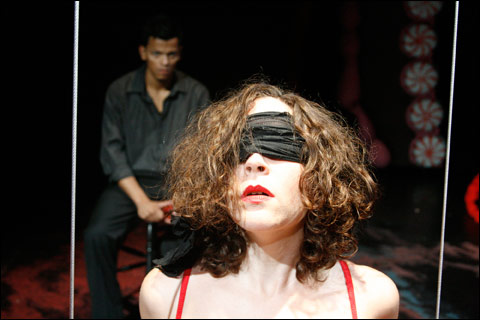
GRIMM TALE: John Kuntz’s stylish S&M gloss on “Little Red Cap” says something about both role playing and the strange dance between control and fear of abandonment. |
The Brothers Grimm generally managed to live up to their name. "Children will listen," warns fairy-tale appropriator Stephen Sondheim in Into the Woods, and indeed, the sinister sibs of bedtime lore assaulted small ears with mayhem ranging from ingestion by wolves to amputation sans anesthesia. Even the happy endings can be gruesome, as when the malefactors of "The White Bride & The Black One" are stuffed into barrels studded with nails and dragged through the streets naked and perforated. Of course, that's of less interest to playwright Lydia R. Diamond than the blatant racism of the tale; one can sense her off-stage eyes growing wide even as they wink at the polarizing prejudice of this lesser-known story in her deliciously simple, ironical gloss — one of seven that make up Grimm, in its world premiere by Company One (at the Calderwood Pavilion through August 14).
Feisty Company One is the organizational brain behind Grimm, and it did not hesitate to drop a dime on the rich and famous — including Wicked author Gregory Maguire, whose aftermath to "Little Snow White," The Seven Stage a Comeback, forms the frame of the captivating if disjointed new theater piece. In addition to bagging Maguire, the troupe commissioned riffs on the Grimms from local bards John ADEkoje, Kirsten Greenidge, and Marcus Gardley (librettist of On the Levee, which recently opened at the experimental venue of Lincoln Center), as well as by Elliot Norton Award winners John Kuntz, Melinda Lopez, and Diamond. The inspirations range from such barnacles on the collective consciousness as "Hansel and Gretel" and "Little Red Cap" to more obscure or puzzling fables like "Clever Else" and "Stories About Snakes." Directors Shawn LaCount and Summer L. Williams, without even attempting a unified style, weave these diverse imaginings into something approaching a whole, abetted by a prominent, magic-enhancing sound design by Arshan Gailus and by Cristina Todesco's set, which is accessorized by red-stemmed flora as well as an Astroturf bunker for the abandoned dwarves and a skateboard ramp that twice proves worthy of rappelling.
Each piece gets a voiceover introduction by the playwright — an intrusive device. Trouble is, even with authorial guidance, the life lessons proffered by the revved-up fables aren't always clear. Freudian scholar Bruno Bettelheim argues that fairy tales get under our skins and remain there because they are analogues for our deepest fears and demonstrate that grappling with those fears leads to knowledge and purpose. To that end, Maguire's cadre of Little People, given the heave-ho rather than the hi-ho by the adoptive daughter they adored, are taken on a journey from depression through anger to understanding, from the accusation that Snow White "stole our laughter" to awe at an infant's chortles. As portrayed by Company One's distinctive troupers, Maguire's Munchkin variants are also good enough to eat. And they'd definitely be safer fare than the gingerbread house, here an artifact in a German museum, that seduces the spoiled American Hansel and Gretel of Gardley's cheeky, ominous, ultimately pointless Half Handsome & Regrettable.